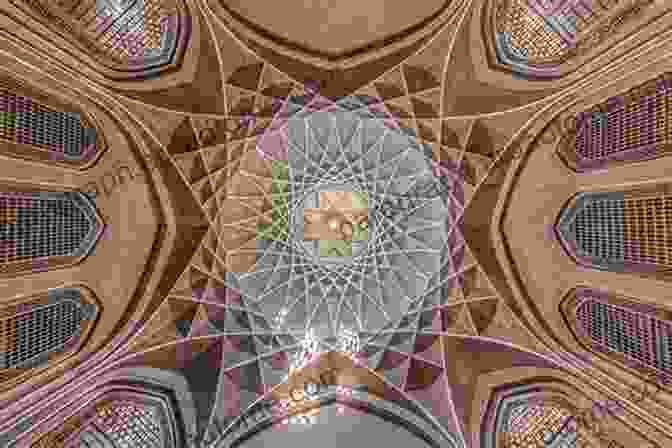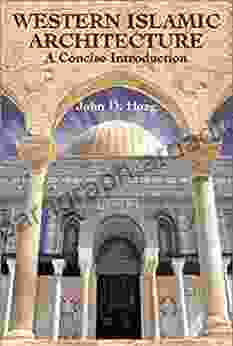Unveiling the Architectural Splendors of the Islamic West: A Journey through Western Islamic Architecture


Western Islamic architecture is a captivating tapestry of artistic expression and architectural innovation that flourished in the Iberian Peninsula, North Africa, and Sicily during the Middle Ages. From the towering minarets of the Great Mosque of Córdoba to the ethereal beauty of the Alhambra in Granada, this architectural legacy stands as a testament to the cultural and artistic achievements of the Islamic world. This comprehensive guide will introduce you to the key characteristics, historical development, and cultural significance of Western Islamic architecture, inviting you on an enthralling journey through its architectural wonders.
5 out of 5
| Language | : | English |
| File size | : | 23826 KB |
| Text-to-Speech | : | Enabled |
| Screen Reader | : | Supported |
| Enhanced typesetting | : | Enabled |
| Print length | : | 195 pages |
| Lending | : | Enabled |
Historical Development
The rise of Western Islamic architecture is intricately tied to the Umayyad conquest of the Iberian Peninsula in 711 AD. The Umayyads, a powerful Islamic dynasty, established a flourishing empire that spanned the vast territory from modern-day Spain to Morocco. Their reign marked the beginning of a new era in Islamic architecture, characterized by a unique blend of local traditions with Islamic architectural principles.
In the 9th century, the Abbasid Caliphate, another major Islamic power, extended its rule over North Africa and Sicily. The Abbasids brought with them their own architectural style, which incorporated elements from the Persian and Byzantine traditions. This fusion of styles further enriched the architectural landscape of the Islamic West, giving rise to new forms and motifs.
The Rise of the Almoravids and Almohads
The 11th and 12th centuries witnessed the emergence of the Almoravids and Almohads, two Berber dynasties that ruled over North Africa and the Iberian Peninsula. These empires played a crucial role in shaping the architectural character of the region. The Almoravids introduced a distinctive style characterized by severe lines, geometric patterns, and massive fortifications. The Almohads, who succeeded the Almoravids, continued this tradition while adding their own embellishments, such as horseshoe arches and elaborate stucco decorations.
The Zenith of Islamic Architecture in the Iberian Peninsula
The zenith of Western Islamic architecture occurred during the Nasrid period in the 13th and 14th centuries. The Nasrids, the last Muslim dynasty to rule the Iberian Peninsula, presided over the creation of architectural masterpieces such as the Alhambra in Granada. The Alhambra is a breathtaking palace complex known for its intricate tilework, delicate archways, and lush gardens. It epitomizes the fusion of Islamic and Spanish architectural traditions, showcasing the cultural harmony that prevailed in the region.
Key Characteristics
Western Islamic architecture is distinguished by several key characteristics that set it apart from other Islamic architectural traditions:
- Pointed Horseshoe Arches: These arches, characterized by their distinctive shape, became a signature element of Western Islamic architecture, replacing the rounded arches commonly found in the East.
- Flattened Domes: Unlike the bulbous domes typical of Eastern Islamic architecture, the domes in the West were often flattened, contributing to a more subtle and visually pleasing aesthetic.
- Varied Roofing Systems: Western Islamic architects employed various roofing systems, including wooden beams, vaults, and domes, adapting to local conditions and materials.
- Decorative Tilework: Tiles became an integral part of Western Islamic architecture, used to adorn walls, floors, and ceilings with vibrant geometric patterns and intricate calligraphy.
- Influence of Local Traditions: Western Islamic architecture incorporated elements from local traditions, such as the Romanesque and Gothic styles in the Iberian Peninsula and the North African influences in the Maghreb.
li>Interlacing Arcades and Courtyards: Arcades, often composed of intricate horseshoe arches, were frequently used to create open, shaded spaces, while courtyards provided a central gathering point and served as a source of ventilation and light.
Cultural Significance
Western Islamic architecture is not merely a collection of buildings; it is a testament to the cultural achievements and artistic prowess of the Islamic civilization. It reflects the cultural and religious beliefs of the period, as well as the social and political structures of the time. The mosques, palaces, and public buildings constructed during this era served as centers of religious, intellectual, and political life.
The architectural legacy of the Islamic West continues to inspire architects and designers to this day. The intricate patterns, harmonious proportions, and innovative construction techniques employed in these architectural wonders have left an indelible mark on the global architectural landscape. From the Alhambra's delicate tracery to the soaring minarets of Córdoba, the architectural heritage of the Islamic West remains a source of fascination and admiration.
Western Islamic architecture is a captivating and visually stunning architectural tradition that has left an enduring legacy on the world. Its unique blend of Islamic principles and local influences gave rise to a rich and diverse array of buildings that showcase the cultural and artistic achievements of the Islamic civilization. This comprehensive guide has provided you with an to the key characteristics, historical development, and cultural significance of Western Islamic architecture. To further immerse yourself in the beauty and grandeur of this architectural tradition, we invite you to explore the pages of "Western Islamic Architecture: A Concise " by Leandro Fernández-Morera. This authoritative and lavishly illustrated volume offers a comprehensive journey through the architectural wonders of the Islamic West, providing a deeper understanding and appreciation of this captivating and inspiring chapter in architectural history.
5 out of 5
| Language | : | English |
| File size | : | 23826 KB |
| Text-to-Speech | : | Enabled |
| Screen Reader | : | Supported |
| Enhanced typesetting | : | Enabled |
| Print length | : | 195 pages |
| Lending | : | Enabled |
Do you want to contribute by writing guest posts on this blog?
Please contact us and send us a resume of previous articles that you have written.
 Book
Book Novel
Novel Page
Page Chapter
Chapter Text
Text Story
Story Genre
Genre Reader
Reader Library
Library Paperback
Paperback E-book
E-book Magazine
Magazine Newspaper
Newspaper Paragraph
Paragraph Sentence
Sentence Bookmark
Bookmark Shelf
Shelf Glossary
Glossary Bibliography
Bibliography Foreword
Foreword Preface
Preface Synopsis
Synopsis Annotation
Annotation Footnote
Footnote Manuscript
Manuscript Scroll
Scroll Codex
Codex Tome
Tome Bestseller
Bestseller Classics
Classics Library card
Library card Narrative
Narrative Biography
Biography Autobiography
Autobiography Memoir
Memoir Reference
Reference Encyclopedia
Encyclopedia Virginia Hamilton
Virginia Hamilton Robert K Elder
Robert K Elder Sterling Saint James
Sterling Saint James Loren M Gelberg Goff
Loren M Gelberg Goff Rose Hart
Rose Hart Jhenah Telyndru
Jhenah Telyndru Kipling D Williams
Kipling D Williams Karen Glass
Karen Glass Suzanne Somers
Suzanne Somers Mario Murillo
Mario Murillo John Mccaslin
John Mccaslin John B West
John B West John Dickson
John Dickson Jessica Weil
Jessica Weil Michael Faudet
Michael Faudet Michael Griesbach
Michael Griesbach Jennifer Keels
Jennifer Keels Niki Alling
Niki Alling Jim Smart
Jim Smart Wendy Shalit
Wendy Shalit
Light bulbAdvertise smarter! Our strategic ad space ensures maximum exposure. Reserve your spot today!

 DeShawn PowellUnlocking Success: Essential Interventions for Asperger Syndrome Adolescents
DeShawn PowellUnlocking Success: Essential Interventions for Asperger Syndrome Adolescents Neal WardFollow ·11.4k
Neal WardFollow ·11.4k Jamie BlairFollow ·9.3k
Jamie BlairFollow ·9.3k Raymond ChandlerFollow ·3.3k
Raymond ChandlerFollow ·3.3k Ernest J. GainesFollow ·2.9k
Ernest J. GainesFollow ·2.9k Oscar WildeFollow ·10.4k
Oscar WildeFollow ·10.4k Morris CarterFollow ·9k
Morris CarterFollow ·9k Edgar HayesFollow ·6.3k
Edgar HayesFollow ·6.3k Hugh BellFollow ·18.3k
Hugh BellFollow ·18.3k

 Julio Cortázar
Julio CortázarAn Illustrated Encyclopedia Of Live Concerts And...
Immerse yourself in the...

 Edgar Cox
Edgar CoxNon Physically Assaultive Attachment Based Chronic Covert...
What is Covert...

 Robert Reed
Robert ReedThe Baseball of Why: Unraveling the Intricacies of...
Step up to the plate and...

 Aldous Huxley
Aldous HuxleyTacos and Beer: An Atmosphere of Flavorful Delights
In the realm of culinary adventures,...

 Stan Ward
Stan WardUnlock the Secrets of the Aramaic Jesus: Revelations of a...
Journey Back to the Roots of...

 Vincent Mitchell
Vincent MitchellMillionaire Success Strategies: Your Blueprint for...
Unlock the...
5 out of 5
| Language | : | English |
| File size | : | 23826 KB |
| Text-to-Speech | : | Enabled |
| Screen Reader | : | Supported |
| Enhanced typesetting | : | Enabled |
| Print length | : | 195 pages |
| Lending | : | Enabled |










